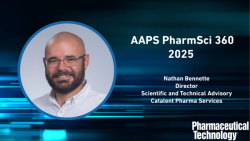
OR WAIT null SECS
- About Us
- Advertise
- Contact Us
- Editorial Info
- Editorial Advisory Board
- Do Not Sell My Personal Information
- Privacy Policy
- Terms and Conditions
© 2025 MJH Life Sciences™ , Pharmaceutical Technology - Pharma News and Development Insights. All rights reserved.
Oligonucleotide-Enabling Technology Pushes Oligos to the Forefront (AAPS PharmSci 360)
Matthew Lauber, senior director—Cell and Gene Therapy, Consumables & Lab Automation, at Waters Corporation highlights how current technologies are enabling oligonucleotide development.
In an exclusive interview with Pharmaceutical Technology®, Matthew Lauber, senior director—Cell and Gene Therapy, Consumables & Lab Automation, Waters Corporation remarks on how current technologies have enabled oligonucleotide (oligo) development to push forward to the forefont.
“Synthetic oligos just so interesting because it is the world in between the biologically produced, recombinantly produced, drugs and those small-molecule drugs that have been produced through traditional synthetic pharma science,” he states.
Much of the work being conducted on oligo drug development has centered around modifications of the oligo molecule, he emphasizes. “Notice that, even in our mRNA [messenger RNA] vaccines, [which gave us] Nobel laureates Karikó and Weissman, one of the big things that unlocked mRNA vaccines was a modified nucleotide,” Lauber notes.
“These are the same things … it's a modification of these things that are our genome code—our transcriptome code— that is giving us our opportunity for a new form of science,” Lauber states.
AAPS PharmSci 360 ran Oct. 22–25 in Orlando, Fl.
View Lauber’s video interviews about oligonucleotide development challenges, the need for new bioanalysis technology, and the oligonucleotide trend.
Related Content:



